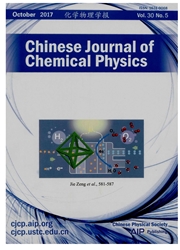

 中文摘要:
中文摘要:
在原子尺度上构建模型,采用密度泛函理论结合准谐波近似研究了氮化硅新相(P6和P6'相)的点阵常数、弹性常数和弹性模量. 并使用β-Si3N4作基准材料来测试计算结果的准确性. 研究发现β-Si3N4的晶胞常数和弹性常数与实验值吻合相当好. 研究了P6和P6'相在30~55 GPa的各向异性因子、脆性和力学稳定性,结果表明两相属于金属性和脆性材料,且晶体的脆性和各向异性都随着压强的升高而增大. β相在40 GPa和300 K时会转变成P6'相. 当压强继续升高到53.2GPa时,P6'相又转化成δ相.同时研究了氮化硅的热容、体积和体模量等性质随温度的变化规律.
 英文摘要:
英文摘要:
Atomistic modeling based on the density functional theory combined with the quasi-harmonic approximation is used to investigate the lattice parameters and elastic moduli of the P6 and P6' phases of Si3N4. β-Si3N4 is set as a benchmark system since accurate experiments are available. The calculated lattice constants and elastic constants of β-Si3N4 are in good agreement with the experimental data. The crystal anisotropy, mechanical stability, and brittle behavior of P6- and P6'-Si3N4 are also discussed in the pressure range of 30-55 GPa. The results show that these two polymorphs are metallic compounds. The brittleness and elastic anisotropy increase with applied pressure increasing. Besides, the phase boundaries of the β→P6'→δ transitions are also analysed. The β phase is predicted to undergo a phase transition to the P6' phase at 40.0 GPa and 300 K. Upon further compression, the P6'→δ transition can be observed at 53.2 GPa. The thermal and pressure effects on the heat capacity, cell volume and bulk modulus are also determined. Some interesting features are found at high temperatures.
 同期刊论文项目
同期刊论文项目
 同项目期刊论文
同项目期刊论文
 Hierarchical Core/Shell NiCo2O4@NiCo2O4Nanocactus Arrays with Dual-functionalities for High Performa
Hierarchical Core/Shell NiCo2O4@NiCo2O4Nanocactus Arrays with Dual-functionalities for High Performa Fabrication and different photoelectric responses of nanocrystalline ZnO film irradiated with UV and
Fabrication and different photoelectric responses of nanocrystalline ZnO film irradiated with UV and Hierarchical mesoporous nickel cobaltite nanoneedle/carbon cloth arrays as superior flexible electro
Hierarchical mesoporous nickel cobaltite nanoneedle/carbon cloth arrays as superior flexible electro Seed-assisted synthesis of highly ordered TiO2@α-Fe2O3 core/shell arrays on carbon textiles for lith
Seed-assisted synthesis of highly ordered TiO2@α-Fe2O3 core/shell arrays on carbon textiles for lith Novel core-shell structured BiVO4 hollow spheres with an ultra-high surface area as visible-light-dr
Novel core-shell structured BiVO4 hollow spheres with an ultra-high surface area as visible-light-dr Growth and electrochemical performance of porous NiMn2O4 nanosheets with high specific surface areas
Growth and electrochemical performance of porous NiMn2O4 nanosheets with high specific surface areas Hierarchical 3D mesoporous conch-like Co3O4 nanostructure arrays for high-performance supercapacitor
Hierarchical 3D mesoporous conch-like Co3O4 nanostructure arrays for high-performance supercapacitor Scalable synthesis of graphene-wrapped Li4Ti5O12 dandelion-like microspheres for lithium-ion batteri
Scalable synthesis of graphene-wrapped Li4Ti5O12 dandelion-like microspheres for lithium-ion batteri Mesoporous,hierarchical core/shell structured ZnCo2O4/MnO2 nanocone forests for high-performance sup
Mesoporous,hierarchical core/shell structured ZnCo2O4/MnO2 nanocone forests for high-performance sup Hierarchical 3D Co3O4@MnO2 core/shell nanoconch arrays on Ni foam for enhanced electrochemical perfo
Hierarchical 3D Co3O4@MnO2 core/shell nanoconch arrays on Ni foam for enhanced electrochemical perfo Solution growth ofNiO nanosheets supported on Ni foam as high-performance electrodes for supercapaci
Solution growth ofNiO nanosheets supported on Ni foam as high-performance electrodes for supercapaci Hierarchical multi-villous nickel-cobalt oxide nanocyclobenzene arrays: morphology control and elect
Hierarchical multi-villous nickel-cobalt oxide nanocyclobenzene arrays: morphology control and elect Mesoporous CuCo2O4 nanograsses as multi-functional electrodes for supercapacitors and electro-cataly
Mesoporous CuCo2O4 nanograsses as multi-functional electrodes for supercapacitors and electro-cataly Hierarchical, porous CuS microspheres integrated with carbon nanotubes for high-performance supercap
Hierarchical, porous CuS microspheres integrated with carbon nanotubes for high-performance supercap Mesoporous ZnCo2O4 nanoflakes grown on nickel foam as electrodes for high performance supercapacitor
Mesoporous ZnCo2O4 nanoflakes grown on nickel foam as electrodes for high performance supercapacitor Facile Synthesis of Graphene-Like Copper Oxide Nano?lms withEnhanced Electrochemical and Photocataly
Facile Synthesis of Graphene-Like Copper Oxide Nano?lms withEnhanced Electrochemical and Photocataly 期刊信息
期刊信息
